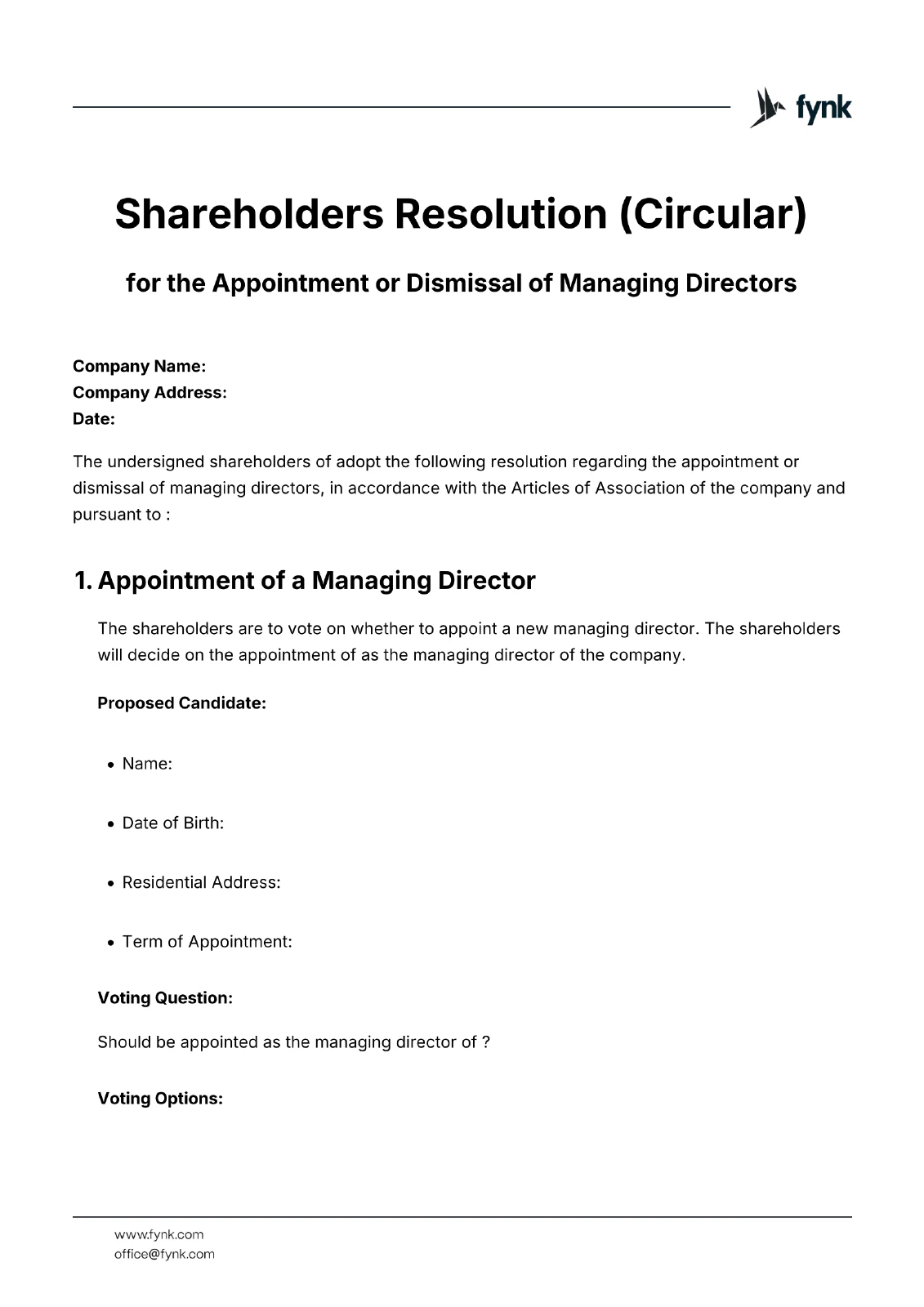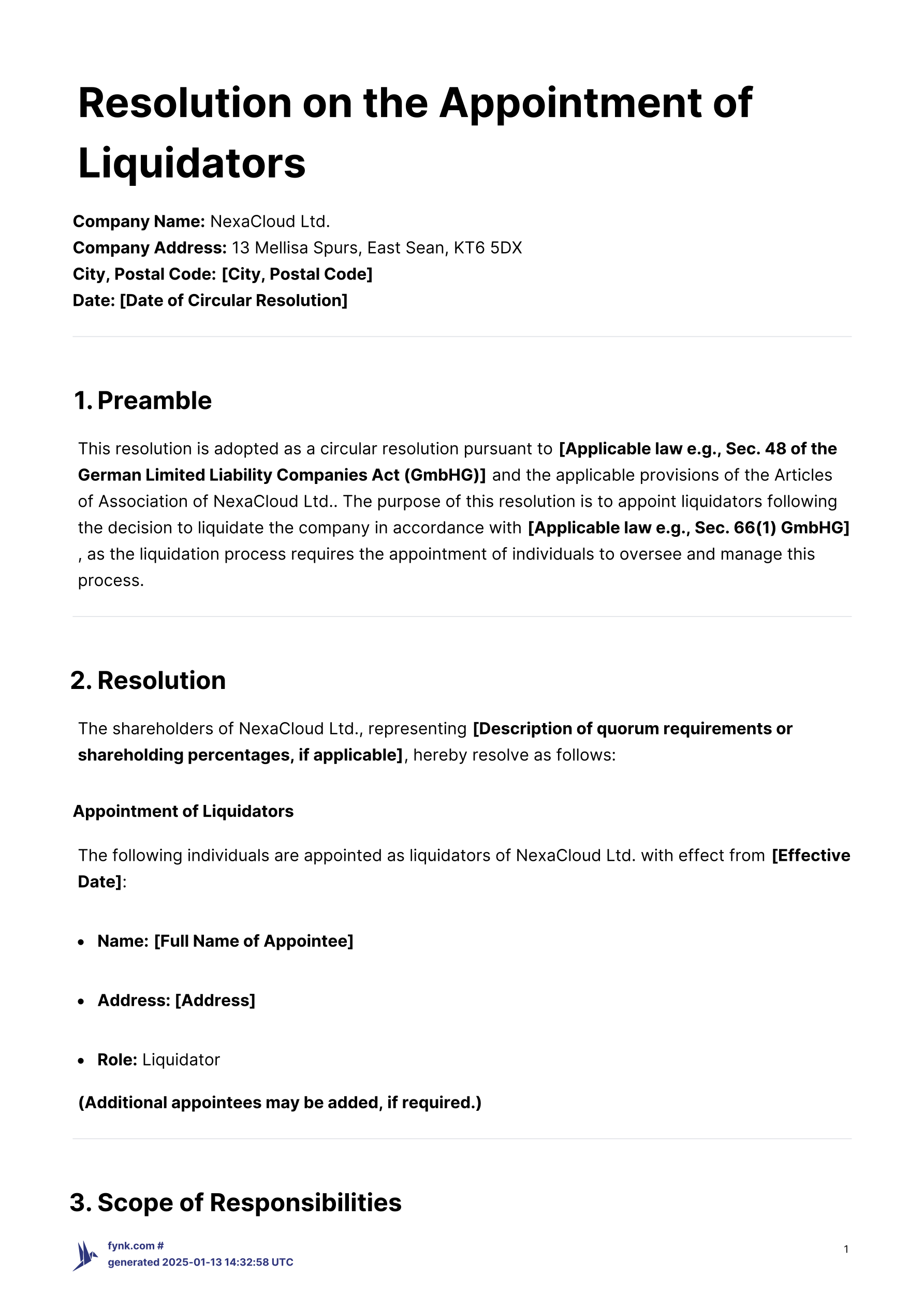Learn everything there is about circular resolution for Changes in company management. What they are, when to use them for and what they should contain.
What is a Circular Resolution for the Appointment or Removal of Managing Directors?
A circular resolution is a way for shareholders to appoint or remove managing directors without needing to meet in person. Instead, the resolution is shared with all shareholders, who can sign off remotely. This method keeps things simple and legally clear, allowing you to manage the company’s leadership without delays. The resolution is circulated to shareholders, and once everyone has signed it, the decision is final. You might use a circular resolution when a director leaves or is removed due to performance issues, and you need to fill the position quickly.
To make a circular resolution for appointing or removing a managing director, you first draft the resolution, including the details of the decision. Then, shareholders review and sign it, either electronically or on paper. (Note, however, that for appointing a managing director, the signature on the circular resolution must be notarized under German law.) For the resolution to be valid, it must follow the company’s rules and local regulations.
Legal Framework for Appoint or Removal of Managing Director Resolutions
The rules for appointing or removing managing directors depend on your company’s articles of association and local law. Based on Germany’s GmbHG, a managing director must be a natural person with full legal capacity and cannot be under guardianship or prohibited from managing a business due to certain legal reasons (Section 6). Additionally, the appointment or removal of a managing director can be decided by shareholders, and the decision is typically formalized in a partnership agreement or through a shareholder resolution.
The appointment can be revoked at any time, unless the partnership agreement specifies otherwise, such as requiring significant cause for revocation (Section 38). The revocation must be registered with the Commercial Register, along with any changes in the managing director’s representation powers (Section 39).
Need a similar template for the appointment or removal of Board Members of an Inc?
And finally, Section 48 of the GmbHG lets you skip the hassle of a physical meeting. Instead, shareholders can vote on the decision remotely by agreeing in writing.
Please note: Although Section 48 permits shareholder voting in writing (i.e. circular resolutions), German law still requires that any circular resolution to appoint a new managing director must bear notarized shareholder signatures. Simply collecting unsigned or purely electronic approvals is not sufficient for appointments; the notary’s attestation is mandatory before filing the appointment with the Commercial Register.
Circular Resolution Template for Appointment or Removal of Managing Directors
Need to draw up a resolution proposal quickly? Our template for circular resolution on appointing or removing managing directors makes it easy for you to handle the decision. It includes all the important points, including the names of the directors involved and the legal framework, so you can stay compliant and organized.
Why you should use fynk’s templates?
Your votes and electronic signatures are encrypted to prevent unauthorized changes, while real-time notifications keep everyone updated throughout the process. You can easily share the resolution with stakeholders, allowing them to review and access it from anywhere. This eliminates the need for physical meetings or endless email exchanges, saving you time. Plus, templates are designed to comply with GmbHG regulations, ensuring you’re always following the legal requirements.
Moreover, you’ll enjoy working with AI-powered digital contract management and benefit from a wide range of features that make handling your documents a breeze.
Can I Use Electronic Signatures for the Circular Resolution?
In general, electronic signatures are acceptable for most circular resolutions, provided they meet German legal requirements for qualified electronic signatures. However, if you are using a circular resolution to appoint a managing director, the shareholder signature must be notarized—an ordinary electronic signature (even if qualified) will not meet the notarization requirement for director appointments. For resolutions that do not involve appointing a managing director (e.g. removal, approvals of financial statements, etc.), a qualified electronic signature is sufficient to avoid signature forgery.
Decisions Requiring a Shareholders’ Meeting with Notary
Some corporate changes cannot be handled by circular resolution—even if all shareholders agree in writing. Specifically:
- Amendments to the articles of association
- Capital measures (e.g. increases or decreases in share capital)
These decisions must be adopted at a physical shareholders’ meeting where a notary is present. Circular resolutions are not permitted for these types of fundamental corporate changes.
FAQs
- Can a circular resolution be used for other decisions aside from appointing or removing managing directors?
- Yes, you can use circular resolutions for other shareholder decisions, as long as your company’s articles allow it. Some of the resolutions that can also be concluded using circular resolutions are the dissolution of the company, financial statements approvals, the conclusion of a specific contract, and denial of information or inspection rights.
- What happens if a shareholder doesn’t sign the resolution?
- If a shareholder doesn’t sign, the resolution won’t be valid unless your articles say otherwise or the quorum requirement is met.
- Do I need to explain why I’m appointing or removing a managing director in the resolution?
- While not always required, it’s a good idea to include reasons to make the process more transparent and avoid confusion.
- Are there any decisions that I cannot make via circular resolution?
- Yes. Under German law, certain fundamental changes—such as amendments to the articles of association or capital measures (e.g. capital increases or decreases)—**must** be adopted at a physical shareholders’ meeting with a notary present. Circular resolutions cannot be used for those kinds of decisions.
Shareholder 1
Shareholder 2
Shareholder 3
Shareholder 1
Shareholder 2
Shareholder 3









